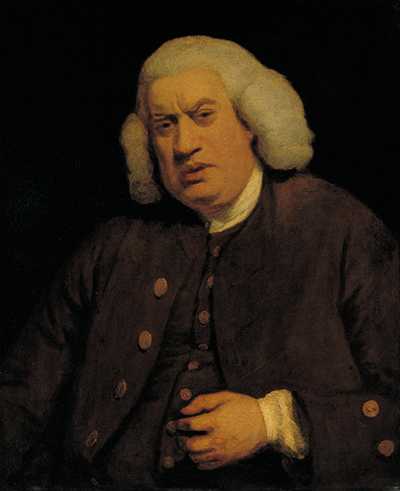 Buy Art Prints Now
Buy Art Prints Nowfrom Amazon
* As an Amazon Associate, and partner with Google Adsense and Ezoic, I earn from qualifying purchases.
Doctor Samuel Johnson by Joshua Reynolds is a well-known portrait of around 1772, although it's not the only rendition of his friend by this prolific artist.
As always in his work, brushwork was applied with long, smooth strokes in subdued hues, with light focused on the centre, providing a contrast which emphasised the intense, intelligent features of the face. Unlike some of his other work where drapes and folds were clearly shown, the background here is dark, which has the effect of drawing attention to the good doctor's coat and collar, in addition to his face. Sir Joshua Reynolds was the most successful portraitist of the eighteenth century, and the Royal Academy's first president. Involved as he was with London intellectual life, he counted Doctor Johnson among his friends. Samuel Johnson remains today a well-known wit and author, perhaps best-known for his Dictionary of the English Language.
Reynolds looked back to the Renaissance, travelling to Italy, and noting the three-dimensional effects of chiaroscuro. Other influences were Van Dyck, Rubens and Rembrandt, from whom he would have picked up the importance of light in portraiture. Many of his themes were classical, popular among the gentry of the day. He reflected the culture and taste of the art establishment at that time, portraying contemporary ideas of virtue, intellect, morals and standing, while also taking on new ideas. He used chiaroscuro to dramatic effect, for example.
Joshua Reynolds preferred tones of black, dark red, white, burnished yellow and ultramarine. Rather than direct mixing, he would apply one colour lightly over another, believing that the eye should feel as well as see the effect. He used a primary colour to focus attention, but liked flesh tints to be accurate. However, time has not been kind to some of his paintings, which have suffered from faulty processes. The reds, mostly carmine, have faded, making flesh appear paler, while the bitumen in the black areas has cracked.
This oil-on-canvas picture was originally commissioned by Henry Thrale for his Streatham Park Gallery in 1772, and is now owned by the Tate Gallery. One of the most influential artists of his day, and admired by Gainsborough, Sir Joshua Reynolds was passionate in his desire to develop new ways of working within art, and in this sense he was a revolutionary in the Age of Enlightment. The way in which all sitters were fashionably-styled, whatever their standing, and the lack of background distractions, feeds into Modernism and at times, Impressionism. This familiar picture of Doctor Samuel Johnson by Joshua Reynolds shows the artist at his best, and confirms his relevance to today's viewer.



